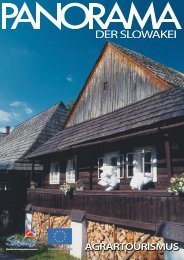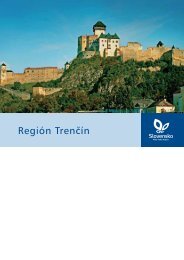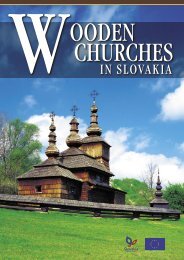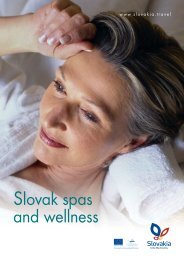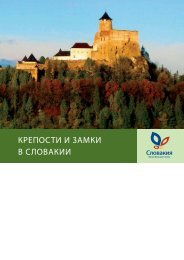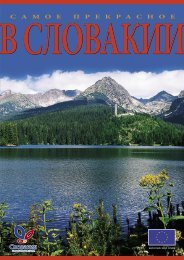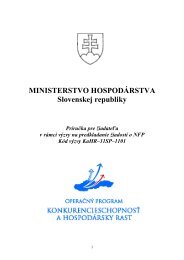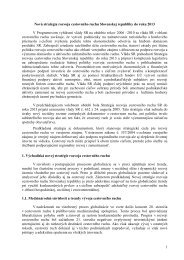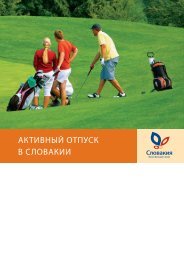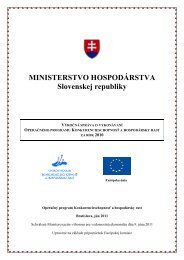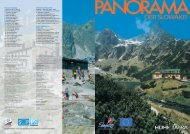Create successful ePaper yourself
Turn your PDF publications into a flip-book with our unique Google optimized e-Paper software.
The starting point from the Kráľova hoľa summit<br />
Climatic<br />
conditions<br />
At the sources of<br />
Slovak rivers<br />
On account of the great differences in altitude, there are as<br />
many as 5 temperature zones within the national park. The<br />
treeless ridges have a harsh climate with average temperatures<br />
of -9°C in January and 7 - 11.5°C in July. The lower mountain<br />
valleys have an average summer temperature of as much as<br />
16°C. From the point of view of winter sports, the slopes that can<br />
be used for the longest period of time are those of Chopok, which<br />
have a covering of snow for up to 130 days in the year.<br />
Avalanches from the steepest slopes of the summits pose a very<br />
serious threat. The snow cover in April and even in May is more<br />
stable and you can experience some fantastic skiing on Chopok<br />
at that time. In summer the weather is very changeable in the Low<br />
Tatras, with frequent local storms, which go as quickly as they<br />
come. For hiking August and September are the most suitable,<br />
when the weather is drier and more settled.<br />
The sporting and tourist activities the slopes and valleys of the Low<br />
Tatras have to offer are primarily downhill and cross-country<br />
skiing, hiking, cycling, mountaineering, rock climbing and<br />
paragliding. The most popular ski resorts are Jasná and Donovaly.<br />
The Low Tatra region provides a vital supply of water. Four<br />
large rivers have their sources on the slopes of Kráľova hoľa<br />
— the Čierny Váh, Hron, Hornád and Hnilec, which is why<br />
the Kráľova hoľa massif is also called "the roof of Slovakia". The<br />
mountain streams, brooks and little rivers actually flow into two<br />
main rivers, the northern slopes of the range being drained by the<br />
longest river in Slovakia, the Váh (403 km) and the southern<br />
slopes by the Hron. In the east, they are helped by the Hnilec.<br />
Near the source of this river a waterfall, Martalúska, cascades<br />
down the Kráľova hoľa hillside. A similar original natural<br />
phenomenon, 30 metres of foaming cascades is to be found in<br />
Vajskovská dolina, one of the longest valleys in the southern<br />
slopes of the Low Tatras. The original technical facilities for<br />
transporting wood down the river have been restored on the<br />
Vajskovský potok.<br />
Many rivers flow underground through the karst landscape, later<br />
surfacing as large springs, especially in the Demänovská and<br />
Jánska valleys. In addition to the sources of drinking water, there<br />
are a number of mineral springs. Health resorts have been<br />
established in Korytnica and Liptovský Ján. Refreshing, pleasanttasting<br />
springs also bubble out of the ground near Moštenice,<br />
Hiadeľ, Jasenie, Mýto pod Ďumbierom, Jarabá, Beňuš, Bacúch,<br />
Liptovská Lúžna, Ludrová, Liptovská Štiavnica, Liptovské Sliače,<br />
Vyšná Boca and Malužiná. In contrast to the High Tatras, the Low<br />
Tatras have few natural lakes. One exception is Vrbické pleso in<br />
Demänovská dolina, which covers 6.2 hectares and lies at an<br />
altitude of 1113 metres above sea level.<br />
Korytnica, a part of Liptovská osada, surrounded by steep hills<br />
with deep coniferous, (mainly spruce) forests, is the highest<br />
located Slovak health resort (825 m). Mineral water<br />
springs from the ground at an altitude of 850 m. The<br />
ferrous, gypseous acidulous mineral water is often compared<br />
to the springs in the Czech town of Karlove Vary and Vichy<br />
in France. In the form of tub baths and drinking cures it<br />
has a positive effect on digestive and metabolic disorders<br />
and disorders of the endocrine glands. Korytnica mineral<br />
water won a gold medal at the World Exhibition as<br />
early as 1873 and in 1904 a silver medal in Saint Louis<br />
in the USA. Korytnica mineral water with its characteristic<br />
taste is bottled to this day and is available in the shops.<br />
The tarn of Vrbické pleso<br />
Pages 6-7<br />
THE LOW TATRAS



